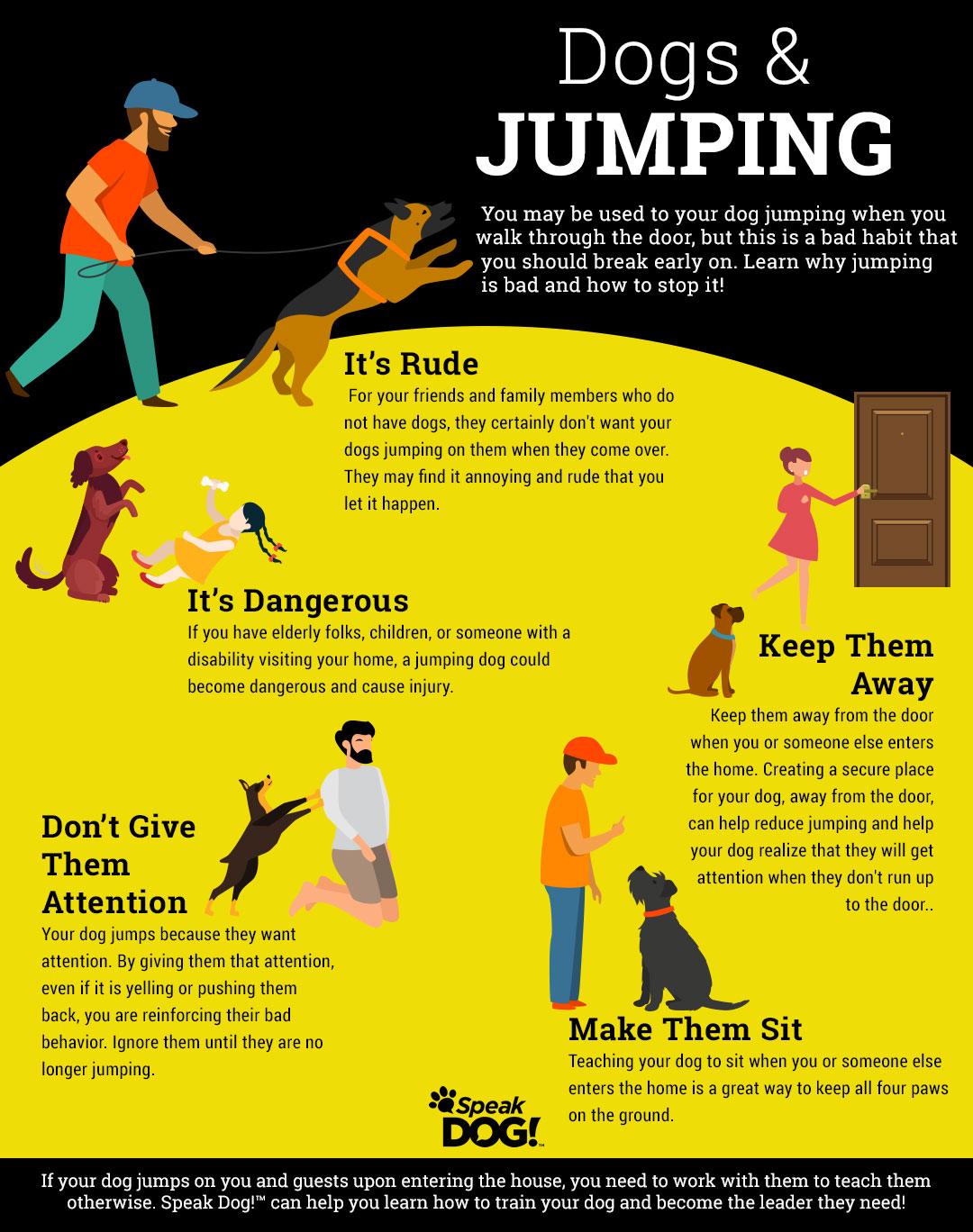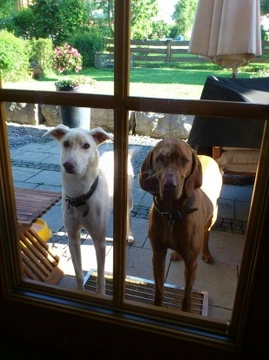Dogs often jump on doors when they are excited or anxious. This behavior can be frustrating for pet owners. So let’s jump in deep: How to Stop a Dog from Jumping on a Door?
It can also lead to damaged doors or scratched surfaces. Understanding why your dog jumps is the first step to solving the problem. Dogs may jump to greet you, seek attention, or express their energy. They often do this when they see something they want outside or when someone arrives.
Stopping this behavior takes patience and consistent training. You need to teach your dog a better way to express excitement. With the right techniques, you can help your dog learn to stay calm and polite. This guide will show you effective methods to stop your dog from jumping on doors.
Table of Contents

Credit: speakdog.com
Introduction To Canine Door-jumping
Dogs often jump on doors for various reasons. This behavior can be frustrating for owners. Understanding why dogs jump can help you manage it better. Let’s explore common reasons and risks associated with door-jumping.
Common Reasons Dogs Jump On Doors
- Excitement: Dogs jump when they are excited. They may see a friend or a family member.
- Attention-Seeking: Dogs want your attention. Jumping can be their way of getting noticed.
- Separation Anxiety: Some dogs feel anxious when left alone. They may jump at the door to escape.
- Curiosity: Dogs are naturally curious. They may jump to see what is on the other side.
- Playfulness: Jumping can be part of their play. Dogs often jump when they want to play.
Potential Risks And Problems
| Risk | Description |
|---|---|
| Injury | Jumping can lead to injuries for both dogs and people. |
| Damaged Doors | Repeated jumping can damage doors and frames. |
| Escaping | Jumping might cause your dog to escape outside. |
| Behavioral Problems | Jumping can lead to other unwanted behaviors. |
Recognizing these risks is important. Addressing door-jumping early can prevent problems later.

Credit: www.reddit.com
Assessing Your Dog’s Behavior
Understanding why your dog jumps at the door is important. Dogs often jump due to excitement or anxiety. By observing their behavior, you can find the right way to help them.
Identifying Triggers
To stop jumping, first identify what causes it. Common triggers include:
- Visitors arriving
- Strange noises outside
- Other animals passing by
- Feeling bored or restless
Keep track of when your dog jumps. Note the situation and your dog’s mood. This can help you understand their behavior better.
Understanding Your Dog’s Body Language
Body language gives clues about your dog’s feelings. Pay attention to:
- Tail position: A high tail means excitement.
- Ears: Forward ears show curiosity.
- Posture: A tense body means stress or excitement.
- Mouth: A relaxed mouth indicates calmness.
Look for signs of anxiety. Signs include:
- Whining or barking
- Pacing back and forth
- Drooling excessively
Understanding these signs helps you respond correctly. A calm dog is less likely to jump.
Basic Training Principles
Training your dog to stop jumping on the door requires understanding basic principles. These principles help create a clear and effective method. Focus on consistency and patience. Use positive reinforcement to reward good behavior. Both methods are essential for successful training.
Consistency And Patience
Consistency is key in dog training. Dogs learn best when they receive the same message each time. Here are some tips to ensure consistency:
- Use the same command word every time.
- Ensure all family members follow the same rules.
- Practice regularly to reinforce learning.
Patience is also crucial. Training takes time. Some dogs learn quickly, while others may take longer. Remember to:
- Stay calm even if progress seems slow.
- Celebrate small victories.
- Give your dog time to understand.
Positive Reinforcement Techniques
Positive reinforcement encourages good behavior. It rewards your dog for doing the right thing. Here are some effective techniques:
- Treats: Offer small treats when your dog stays calm.
- Praise: Use a cheerful voice to praise your dog.
- Toys: Use favorite toys as rewards for good behavior.
Use these tips to reinforce training:
| Behavior | Reward |
|---|---|
| Staying calm by the door | Treat or praise |
| Sitting on command | Toy or petting |
| Not jumping on the door | Special treat or favorite game |
With time, your dog will learn to stay calm by the door. Using these principles creates a positive environment for training.

Credit: m.facebook.com
Preventive Strategies
Stopping a dog from jumping on a door starts with preventive measures. These methods help manage your dog’s behavior. They focus on keeping your dog calm. Consistency is key to success.
Exercise And Mental Stimulation
Regular exercise helps reduce excess energy. A tired dog is less likely to jump. Aim for at least 30 minutes of physical activity each day. Activities can include:
- Daily walks
- Playtime in the yard
- Fetch games
- Agility training
Mental stimulation is equally important. Engaging your dog’s mind can prevent boredom. Use interactive toys or puzzles. Teaching new commands can also keep your dog focused. Consider these options:
- Hide and seek games
- Trick training sessions
- Scent work activities
Door Access Management
Controlling access to doors can help manage jumping. Create a barrier to limit your dog’s movement. Use baby gates or closed doors. This prevents the dog from rushing to the door. Here are some effective methods:
| Method | Description |
|---|---|
| Baby Gates | Use gates to block off door areas. |
| Leash Training | Use a leash to control your dog near doors. |
| Training Commands | Teach commands like “stay” or “sit” at the door. |
Practice these strategies consistently. Reward your dog for calm behavior. This will help reduce jumping at the door.
Correcting The Jumping Habit
Dogs often jump on doors due to excitement or anxiety. Correcting this behavior takes patience and consistency. Use clear commands and redirect their energy. This section will cover effective methods to help stop your dog from jumping.
Command Training
Teaching your dog simple commands can help manage their jumping. Commands like “sit” and “stay” are useful. Here’s how to start:
- Choose a Quiet Space: Start training in a calm environment.
- Use Treats: Keep treats handy to reward good behavior.
- Introduce Commands: Say “sit” or “stay” clearly.
- Reward Success: Give treats immediately when they obey.
- Practice Often: Repeat these commands daily for best results.
Be patient. Some dogs learn faster than others. Consistent practice helps them understand.
Redirecting Energy And Attention
Redirecting your dog’s energy can stop jumping. Provide alternative activities. Here are some effective methods:
- Use Toys: Give them a favorite toy to distract them.
- Play Fetch: Engage in a game of fetch to burn energy.
- Take Walks: Regular walks help reduce excess energy.
- Teach Tricks: Teach tricks like “roll over” or “shake hands.”
Redirecting their focus keeps them occupied. This can help reduce jumping. Be consistent with these activities. Over time, your dog will learn to stay calm.
Advanced Training Tips
Stopping a dog from jumping on a door requires advanced training. These methods help teach your dog proper behavior. Use simple techniques to make learning easy for both of you.
Clicker Training For Door Manners
Clicker training is a fun way to teach your dog door manners. This method uses a click sound to mark good behavior.
Here’s how to use clicker training:
- Get a clicker and some treats.
- Open the door slowly.
- Wait for your dog to stay calm.
- Click and give a treat when they are calm.
- Repeat this until your dog understands.
Be patient. Dogs learn at their own pace. Always reward good behavior. This builds positive habits.
Impulse Control Exercises
Impulse control exercises help your dog learn patience. These activities teach them to wait for your command before acting.
Try these simple exercises:
- Stay Command: Teach your dog to stay when you open the door.
- Wait for Release: Use a release word like “okay” to let them know it’s time to go.
- Door Games: Play games where your dog has to stay behind a line until you say they can cross.
Practice these exercises daily. Gradually increase the difficulty. This way, your dog learns to control their excitement.
Involving Professional Help
Sometimes, stopping a dog from jumping on a door requires expert help. Professional trainers can provide tailored strategies. They understand dog behavior better than most. Their experience can make a big difference.
When To Consult A Trainer
Recognizing the right time to consult a trainer is crucial. Here are some signs that you need help:
- Your dog jumps excessively and does not respond to basic commands.
- You feel overwhelmed and unsure about training methods.
- Your dog shows signs of anxiety or aggression when jumping.
- You have tried various techniques without success.
These situations indicate that a professional trainer may help. A trainer can provide personalized guidance. They can address specific issues with your dog.
Choosing The Right Expert For Your Dog
Selecting the right trainer is important. Here are some factors to consider:
- Look for trainers with positive reinforcement methods.
- Check their certifications and experience.
- Read reviews from other dog owners.
- Ask about their approach to jumping behavior.
Consider meeting the trainer before making a decision. Observe how they interact with dogs. Ensure they understand your dog’s needs.
Choosing the right expert can lead to better behavior. Your dog will learn to stop jumping on doors effectively.
Maintaining Progress
Keeping your dog from jumping on the door takes work. It requires a plan and daily effort. With the right approach, you can help your dog learn better habits.
Daily Routine Adjustments
Make small changes to your daily routine. These changes help your dog understand what is expected. Here are some tips:
- Set a schedule: Stick to a regular feeding and walking schedule.
- Practice commands: Regularly practice commands like “sit” and “stay.”
- Reward good behavior: Use treats or praise when your dog remains calm.
- Avoid triggers: Identify and minimize situations that cause jumping.
Long-term Behavioral Management
Long-term success requires patience and consistency. Focus on these strategies:
- Consistency: Use the same commands and signals each time.
- Gradual exposure: Slowly expose your dog to door-related situations.
- Training sessions: Keep training sessions short but frequent.
- Seek help: Consider hiring a professional trainer if needed.
Track your dog’s progress. Note improvements and setbacks. Adjust your routine as necessary. With effort, your dog will learn to stay calm at the door.
Dealing With Setbacks
Training a dog takes time and patience. Setbacks can happen. Sometimes, dogs revert to old habits. This can be frustrating. Understanding how to handle these setbacks is key.
Identifying Causes Of Regression
Understanding why your dog jumps again is important. Several factors may cause this behavior:
- Stress: Changes in the home can upset your dog.
- Excitement: New visitors or loud noises can trigger jumping.
- Health Issues: Pain or discomfort can alter behavior.
- Inconsistent Training: Mixed signals can confuse your dog.
Pay attention to your dog’s environment. Notice any changes that could affect behavior.
Adjusting Your Approach
When setbacks occur, modify your training methods. Here are some tips:
- Stay Calm: Your reaction matters. Stay composed.
- Reinforce Positive Behavior: Reward calm behavior. Use treats.
- Practice Consistency: Use the same commands every time.
- Increase Training Sessions: Shorter, more frequent sessions work well.
- Avoid Punishment: It can increase anxiety. Focus on rewards.
Adjusting your approach can help your dog learn. Patience is vital. Keep working together.
Frequently Asked Questions
How Can I Train My Dog Not To Jump?
To train your dog not to jump, use consistent commands. Teach “sit” or “stay” before opening the door. Reward calm behavior with treats. Be patient and practice regularly. This helps your dog learn appropriate greetings without jumping.
What Are Effective Methods To Stop Jumping?
Effective methods include positive reinforcement and redirection. Use a leash to control your dog’s movements. Teach alternative behaviors, such as sitting or lying down. Consistency is key, so ensure everyone follows the same approach to reinforce good habits.
Why Does My Dog Jump On The Door?
Dogs jump on doors for attention or excitement. They may be anticipating your arrival or seeking to greet visitors. Understanding this behavior is essential for addressing it effectively. Redirect their energy towards more appropriate actions, like sitting quietly.
When Should I Start Training My Dog?
Start training your dog as early as possible. Puppies can begin learning basic commands around 8 weeks old. Early training establishes good habits. Consistent reinforcement is crucial for long-term success in preventing jumping behaviors.
Conclusion
Stopping your dog from jumping on the door takes patience. Use consistent training and positive reinforcement. Set clear boundaries for your dog. Reward good behavior with treats or praise. Remember to practice regularly. Over time, your dog will learn what you expect.
Enjoy a calmer home environment. With effort, you can change this behavior. Your dog can be well-behaved. Focus on the steps outlined in this guide. You’ll see great progress together.



